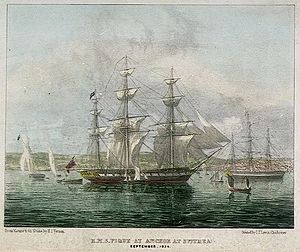HMS Pique (1834)
 HMS Pique off Spithead, 1836
| |
| History | |
|---|---|
| Name | HMS Pique |
| Builder | Devonport |
| Launched | 21 July 1834 |
| Fate | Broken up, 1910 |
| General characteristics | |
| Class and type | Fifth-rate frigate |
| Tons burthen | 1,633 tons |
| Length | 160 ft (49 m) |
| Beam | 49 ft (15 m) |
| Sail plan | Full-rigged ship |
| Armament | 36 × 32-pounder guns |
HMS Pique was a wooden fifth-rate sailing frigate of the Royal Navy, launched on 21 July 1834 at Devonport. She was of 1633 tons and had 36 guns. She was broken up in 1910.
Service history
Under the command of Captain Edward Boxer (3 August 1837 - August 1841), she sailed to North America, the West Indies and the Mediterranean, including operations on the coast of Syria, as part of the squadron led by HMS Cambridge, and including Zebra and Vesuvius.

In 1840 Pique saw service in the bombardment of the city of Acre under the command of Admiral Robert Stopford. For the engagement, Pique was assigned to the far northern end of the line, north-northeast of the much larger HMS Waterloo and at a greater distance from the city than the rest of Stopford's fleet.[1] Despite this unfavourable position, accurate gunnery enabled Pique to score several hits on the town. In 2012 renovation works along Acre's city wall uncovered three cannonballs fired by Pique during the battle, the shots having struck within three metres of each other and embedded in the wall at depths of up to 65 centimetres.[1]
Between 1841 and 1846 Pique served on the North America and West Indies Station. With HMS Blake, in 1845 she acted as a cable ship for experiments in laying telegraph cable in Portsmouth Harbour.[2] From 26 December 1853 she was commanded by Captain Frederick Nicolson on the Pacific Station, and participated in the 1854 Anglo-French squadron sent to the Russian War and Second Anglo-Chinese War). She was present at the Siege of Petropavlovsk.
From 1872 she was a receiving ship, and from 1882 rented as a hospital hulk to Plymouth Borough Council to quarantine sailors who fell victim to a cholera epidemic.[3]
Fate
Pique was broken up in 1910.
References
- ^ a b Kahanov et al, 2014, pp. 147-149
- ^ atlantic-cable.com
- ^ Moseley, Brian (15 January 2011). "Hospital Ships in Plymouth Sound". The Encyclopaedia of Plymouth History. Archived from the original on 19 December 2013. Retrieved 12 February 2015.
Bibliography
- Colledge, J. J.; Warlow, Ben (2006) [1969]. Ships of the Royal Navy: The Complete Record of all Fighting Ships of the Royal Navy (Rev. ed.). London: Chatham Publishing. ISBN 978-1-86176-281-8.
- Kahanov, Yaacov; Stern, Eliezer; Cvikel, Deborah; Me-Bar, Yoav (2014), "Between Shoal and Wall: The naval bombardment of Akko, 1840", The Mariner's Mirror, 100 (2): 147–167, doi:10.1080/00253359.2014.901699
- Lavery, Brian, The Ship of the Line - Volume 1: The development of the battlefleet 1650-1850, 1983, ISBN 0-85177-252-8
